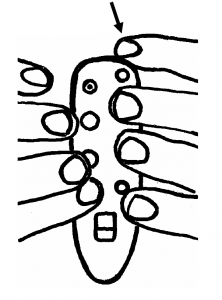FAQ – Frequently Asked Questions
- How to hold your ocarina when playing high notes
- Are your ocarinas accurately tuned?
- Should I curve my fingers when I play your ocarinas?
- What is the fingering pattern for your flutes?
- What is the tonal range of your ocarinas?
- I have large hands. Can I still play your ocarinas?
- How often do you have to clean your ocarinas?
How to hold your ocarina when playing high notes

To play high notes, you must remove most or all of your fingers from their corresponding toneholes.
How, then, do you avoid dropping your ocarina?
As depicted here, support your ocarina by slipping your right little finger onto the end of the ocarina each time you play a B (on the middle line of the staff) or any note above a B.
Moving your right little finger back and forth like this will feel awkward at first, but it will become automatic with practice.
Are your ocarinas accurately tuned?
Yes. Our ocarinas are accurately tuned. However, one thing to keep in mind is that ocarinas (and many other folk flutes) are affected by blowing pressure. In other words, as you blow harder, pitch rises. Thus, playing in tune is akin to singing in tune. You listen to surrounding musicians and play accordingly. For example, if you are slightly flat in relation to other musicians, you play with a little more breath pressure. This becomes more natural after you have played the instrument a while and have made it your own.
Should I curve my fingers when I play your ocarinas?
Yes. Our ocarinas are best played with curved fingers, although you can keep the pinkies straight.
Where can I find fingering charts for Mountain Ocarinas?
Please go to this page.
Can you explain how your flute’s fingering works?
The fingering of our G and C ocarinas is exactly the same except for an extra low note below the lowest note on the scale. The G ocarina uses an additional left pinky finger tonehole to play that note. The equivalent note on the C ocarina is played by blowing more softly.
Here are the basic fingerings for our C ocarinas–without the sharps and flats. (The same fingering pattern also applies to our G ocarinas.) Start with all nine toneholes covered and blow to play a C. Then raise your right pinky to play a D, then your right ring finger to play an E, then your right middle finger to play an F, then your right index finger to play a G, then your left ring finger to play an A, then your left middle finger to play a B, then your left index finger to play a C, then your right thumb to play a D, and finally your left thumb to play an E. In other words, 1) right hand fingers, 2) left hand fingers, 3) right thumb, and 4) left thumb. (Of course, I already mentioned the low B in an earlier paragraph of this email.)
As far as chromatic notes, they are played by different fingerings, so you don’t have to half-cover toneholes to play the sharps and flats. For example, a “B” is played by covering the left index finger tonehole and the two thumb toneholes, whereas a Bb is played by covering the left middle finger tonehole and the two thumb toneholes. See the Fingering Diagrams page for more details.
What is the tonal range of your ocarinas?
The reading range of our ocarinas is B, C, D, E, F, G, A, B, C, D, E with all the sharps and flats, so you can play any songs that fit that range. Because this is the comfortable vocal range, there is virtually unlimited music in this range, but your recorder and tin whistle books may or may not work well.
Also, in the same way that they teach you to play tin whistles in different keys as D whistles, we teach you to read music with our G ocarina as if it were a C ocarina. Thus, the G and C ocarinas finger identically. However, in our Favorite Carols in Easy Keys book, we include a simple tutorial that quickly teaches you to read music with the G ocarina as a true G instrument so that your range would be as follows: F#, G, A, B, C, D, E, F#, G, A, B with all the sharps and flats. In this range, I pick up a lot of fiddle and tin whistle music and anything written for the Highland Bagpipes or Irish Warpipes.
The tonal range of our C ocarina is: B4 – E6. The tonal range of our G ocarina is 5 steps higher: F#5 – B6.
I have large hands. Can I still play your ocarinas?
Yes. I have large hands (I wear extra large gloves), and I love playing the G (smaller instrument) as well as the C. One thing to keep in mind is that our ocarinas are best played with curved fingers (unlike some other instruments which are played best with flat fingers). If you have large hands and tried to play our instruments with flat fingers, you may find it difficult. I haven’t run in to any customers (yet) whose fingers were too large to play our ocarinas.
How often do you have to clean your ocarinas?
Our ocarinas are very carefree. Under ordinary circumstances, you really don’t have to clean the sound chamber. After playing, just store your ocarina in a case or bag that breathes well, i.e., not a plastic bag.
The only cleaning our ocarinas usually need is an OCCASIONAL polishing of the windway with a piece of folded paper. On the fingering/tips sheet included with each ocarina, we explain how to polish the windway every once in a while.
Why don’t you have to clean your ocarina’s sound chamber after each use? After all, the sound of tubular woodwinds –especially the recorder– will degenerate over time if you don’t swab out the bore after each playing session. Well, unlike tubular flutes, the sound of vessel flutes (such as ocarinas) is not affected by moisture in the chamber. Also, the sound chamber of our flutes is small, open, and well-aerated by many holes, so they dry out nicely after each playing.
Here’s an example of how carefree Mountain Ocarinas are. At large conventions, I used to sit at our booth and literally play my ocarina all day. At the end of the day, I’d tuck my ocarina into a cell phone case and head home. The next day I’d simply slip out my ocarina and play it again with no problems whatsoever.
Please note: If you store one of our Warmstone ocarinas in your pocket, we suggest that you keep it in some kind of breathable case. This will protect it from lint and from tiny scratches at the hands of the abrasive stuff that lurks in pockets.
Why does the C ocarina have one less hole than the G instrument? Does it have one less note?
Both ocarinas play the same number of notes.
Both our C and G ocarinas follow the same linear fingering pattern, both are fully chromatic without half covering toneholes, and both play an extra low note. The only difference in fingering between the two is that you cover an extra left pinky tonehole to play that low note on the G ocarina whereas you blow differently to play the lowest note on the C ocarina.
Omitting the lowest note referred to above, here is the basic fingering pattern to sound the notes C, D, E, F, G, A, B, C, D, and E on our C ocarina. Start with all nine toneholes covered: four fingers on the right hand, three fingers on the left hand, and two thumbholes. Blow into the ocarina to sound a low C. Raise your right pinky to sound a D, then your right ring finger to sound an E, then your right middle finger to sound an F, then your right index finger, then your left ring finger, then your left middle finger, then your left index finger, then your right thumb, and finally your left thumb. In other words, 1) right hand fingers, 2) left hand fingers, 3) right thumb, and 4) left thumb.


